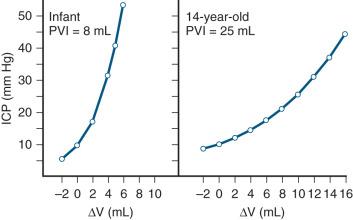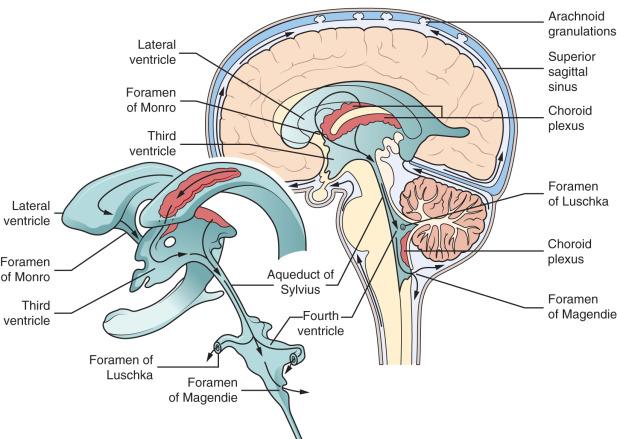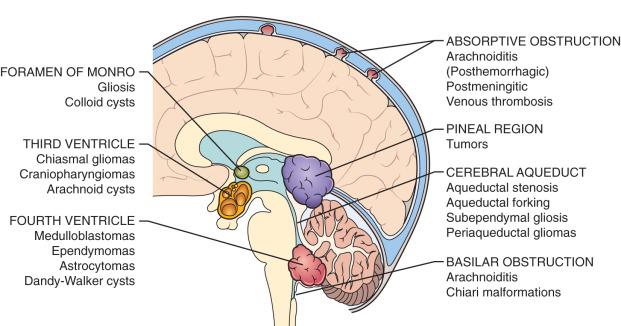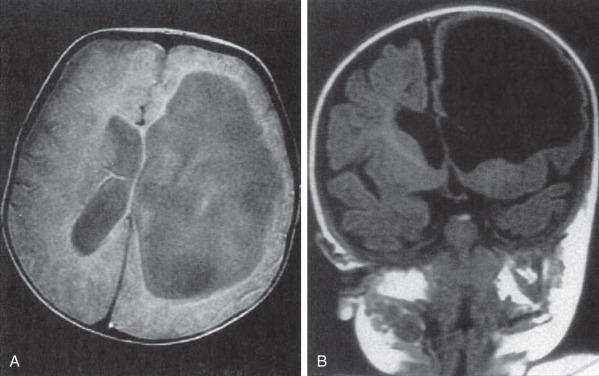Physical Address
304 North Cardinal St.
Dorchester Center, MA 02124
Hydrocephalus is one the most common conditions treated by neurologic surgeons, particularly among the pediatric population. It can also be one of the most challenging.
Obstruction of cerebrospinal fluid (CSF) pathways or impaired CSF resorption causes hydrocephalus, which is characterized by a pathologic accumulation of CSF that ultimately leads to elevated intracranial pressure, neurologic compromise, and, if untreated, coma and death.
CSF shunts are lifesaving treatments for hydrocephalus, but they are not without their problems. Complications of shunt placement include shunt failure, over- or underdrainage, and infection.
Endoscopic third ventriculostomy (ETV) is an alternative treatment that alters CSF flow patterns by creating a fenestration at the floor of the third ventricle. If successful, this operation can obviate the need for a shunt in selected patients. The three factors that have the most predictive value for ETV success are age, etiology of hydrocephalus, and prior shunt.
Hydrocephalus is one of the most common conditions treated by neurologic surgeons, particularly among the pediatric population, where the incidence is roughly 1 : 1000. It generates considerable strain on patients, families, and the health care system overall, accounting for approximately 40,000 hospital admissions and $2 billion in health care expenditures annually in the United States. Hydrocephalus is characterized by a pathologic accumulation of cerebrospinal fluid (CSF) that can lead to elevated intracranial pressure (ICP), neurologic compromise, and, if untreated, coma and death.
By the time a child reaches 2 years of age, the cranial sutures have fused, rendering the skull rigid, with a fixed volume. As with any inflexible container, the internal pressure is determined by its contents. In a normal, healthy child, these include the brain (80%), CSF (10%), and intravascular blood (10%). An increase in any of these components will lead to a rise in the ICP, a relationship known as the Monro-Kellie doctrine . Normal values for ICP vary substantially with age, from ≤2 mm Hg in neonates to ≤15 mm Hg in adolescents and adults ( Table 8.1 ). Mass lesions such as tumors and hematomas constitute an additional compartment and place stress on the system, causing an increase in ICP. Healthy children are able to compensate for the increasing pressure because of the capacitance provided by the compressible, low-pressure veins and the CSF spaces. As pressure rises, CSF drains from the ventricles into the subarachnoid space and, ultimately, into the venous system, thereby reducing CSF volume; however, mass lesions of sufficient size can overwhelm these compensatory mechanisms, leading to significant increases in ICP. Elevated ICP causes a drop in cerebral perfusion pressure, defined as the difference between the mean arterial pressure and the ICP. As cerebral perfusion pressure drops, ischemia ensues.
| Age | Intracranial Pressure Range (mm Hg) |
|---|---|
| Neonate | <2 |
| Infant | 1.5–6 |
| Young child | 3–7 |
| Adolescent and adult | <15 |
Pediatric hydrocephalus patients with fused cranial sutures are particularly vulnerable because the CSF compartment offers little additional compliance. Compliance refers to the rate of pressure change versus volume increase, and children with poor compliance experience a larger increase in pressure for a given volume change. Alternatively, the pressure–volume relationship may be quantified in the form of the pressure–volume index (PVI), which is the volume change required to produce a tenfold change in ICP. Importantly, the PVI changes significantly with age; the PVI is 25 mL in teenagers, but only 8 mL in infants ( Fig. 8.1 ). Consequently, a change in CSF volume that would be well tolerated by a 14-year-old adolescent can be lethal in a younger child.

CSF is a clear, colorless fluid that surrounds the brain and spinal cord. It is produced principally by the choroid plexus of the cerebral ventricles, although there is also significant contribution from the ependymal lining of the ventricles and spinal cord. The choroid plexus is a villous structure composed of cuboidal epithelium surrounding a core of highly vascular connective tissue. It produces CSF through ultrafiltration at a rate of 0.35 mL per minute, or approximately 500 mL per day in an adult. Compared with plasma, CSF has lower levels of potassium, calcium, glucose, bicarbonate, and total protein than serum ( Table 8.2 ) ; these gradients are established by active transport in the choroid plexus epithelium and are maintained by tight junctions between these cells. CSF protects the brain from mechanical forces and serves as an additional circulatory mechanism for removal of waste products and hormone transport. Approximately 10% of the CSF volume is found within the ventricular system, with the remainder in the spinal and intracranial subarachnoid spaces.
| Component | Cerebrospinal Fluid | Blood Plasma |
|---|---|---|
| Concentration/mg (100 mL) −1 | ||
| Protein | 16–38 | 6300–8500 |
| Sugar | 45–80 | 80–120 |
| Amino acids | 1.5–3 | 4.5–9 |
| Creatinine | 0.5–2.2 | 0.7–2 |
| Uric acid | 0.4–2.8 | 2.9–6.9 |
| Urea | 5–39 | 22–42 |
| Cholesterol | trace | 100–150 |
| Lactic acid | 8–25 | 10–32 |
| Phosphate (inorganic) | 3.4 | 4.7 |
| Concentration/mmol kg −1 | ||
| Na+ | 147 | 150 |
| K+ | 2.86 | 4.63 |
| Ca2+ | 1.14 | 2.35 |
| Mg2+ | 1.1 | 0.8 |
| Cl − | 113 | 99 |
| |
23.3 | 26.8 |
| pH | 7.3 | 7.4 |
CSF physiology and pathophysiology are not completely understood and remain an area of ongoing research. The classic hypothesis describes a “bulk flow” model ( Fig. 8.2 ), where CSF produced in the ependyma and choroid plexus flows from the lateral ventricles, through the foramina of Monro, and into the third ventricle. From there, it travels down the aqueduct of Sylvius and into the fourth ventricle. It then leaves the ventricular system through the foramina of Luschka and Magendie, entering the subarachnoid space of the basal cisterns. The flow continues up over the cerebral convexities to the arachnoid granulations, where it is resorbed into the venous system by a pressure-dependent mechanism. According to this theory, obstruction at any point along this pathway leads to accumulation of CSF and, consequently, hydrocephalus.

This explanation of CSF physiology is not without flaws, however. For example, CSF production is not truly limited to the ventricles, but instead occurs at a slower rate throughout the subarachnoid space because of hydrostatic and osmotic forces. Similarly, although arachnoid granulations contribute substantially to CSF resorption, many authors now believe that this process takes place at multiple sites, such as nerve root sheaths and the lymphatics of the cribriform plate. Indeed, Dandy himself reported experimental evidence of absorption outside of the arachnoid granulations ; dye injected via lumbar puncture could be seen in the bloodstream within 2 minutes, but was not observed in the cortical subarachnoid space until an hour had passed.
The bulk flow model is also an imperfect explanation for the development of hydrocephalus. Although it is intuitively obvious that an obstruction in the ventricular system could block flow and lead to CSF accumulation and engorgement of the ventricular system proximally, it is not clear how obstruction at the arachnoid granulations or the venous system would lead to preferential ventricular dilation; all CSF spaces should be equally affected, including the cortical subarachnoid space, but this is seldom seen in clinical practice.
In reality, CSF dynamics are not as simple and straightforward as the bulk flow model suggests. Instead, we now know that CSF flow is not truly continuous and unidirectional; rather, CSF pulsates to and fro as the cerebral blood volume changes in sync with the cardiac cycle, attenuating the strong pressure waveforms entering the cranial vault through the arterial system. These CSF pulsations can be seen in patients with ventriculostomy catheters, and they can be readily imaged using cardiac-gated dynamic phase-contrast magnetic resonance imaging (MRI). The slow anterograde bulk flow is superimposed on these pulsations in healthy individuals and is thought to occur during inspiration as negative intrathoracic pressures are transmitted to the cranial subarachnoid spaces through the venous system.
Because of the limitations of the classic bulk flow model, an alternative “hydrodynamic model” of hydrocephalus has been proposed. In this model, intracranial pulsations, not obstructed CSF flow, are the primary drivers of hydrocephalus. Proponents of this model contend that the root cause of hydrocephalus is impaired intracranial compliance, which leads to increased arterial pressure waves in the parenchyma. These pressure waves are transmitted to the capillary beds, increasing downstream arterial resistance and further amplifying arterial pressure waveforms. Experimental evidence suggests that increased pulsatility within the ventricle can cause ventriculomegaly, but the mechanism underlying this process is not well understood.
We favor an explanation that incorporates elements of both models. Certainly, the bulk flow model is practical for conceptualizing how obstructive lesions result in predictable patterns of “upstream” ventricular dilation. In our view, patients with hydrocephalus have higher pressure and thus poor compliance from some form of imbalance between CSF production and absorption. This imbalance may be limited to one portion of the ventricular system, as in the case of an obstructive lesion, or it may be due to impaired CSF absorption into the venous system. Regardless, the progressive accumulation of CSF increases pressure, impairs compliance, and reduces the brain's ability to attenuate intracranial pulsations with each heartbeat. The relative contributions of these factors remain uncertain, and the field of hydrocephalus research has not coalesced around a unified model that fully explains the physiology and pathophysiology of CSF dynamics. This point is underscored by the fact that debates continue within the community regarding the definition and classification of hydrocephalus.
Classically, hydrocephalus has been classified as obstructive or nonobstructive, which is a somewhat misleading nomenclature because all forms of hydrocephalus involve some form of CSF obstruction under the bulk flow model. The only exception is hydrocephalus ex vacuo, which is not true hydrocephalus but rather ventriculomegaly caused by brain atrophy. A more commonly employed classification describes hydrocephalus as either communicating or noncommunicating. Historically, communicating hydrocephalus was diagnosed with pneumoventriculography, which allowed for visualization of ventricular anatomy using plain radiographs after replacing CSF with air. With modern neuroimaging, this test is rarely performed; hydrocephalus is now described as noncommunicating when it is caused by lesions that obstruct CSF flow through the ventricular system, such as fourth ventricular tumors. Communicating hydrocephalus is present when the lesion is at the level of the subarachnoid spaces, arachnoid granulations, or the venous system. Fig. 8.3 demonstrates several common sites of obstruction with common lesions that occur in those locations. Rekate has proposed a classification system that defines different forms of hydrocephalus by the site of anatomic obstruction: foramen of Monro, aqueduct of Sylvius, outlets of the fourth ventricle, basal cisterns, arachnoid granulations, venous outflow, or none (eg, choroid plexus papilloma–related CSF overproduction).

Choroid plexus tumors compose 1.5% to 3.9% of pediatric brain tumors, an incidence that is three times higher than in the overall population. They are particularly common in children under the age of 3 years, and the majority are benign choroid plexus papillomas. CSF production rates three to four times normal have been described in children with these lesions, and surgical resection cures the hydrocephalus in approximately two-thirds of cases. Choroid plexus tumors and other intraventricular masses can also cause monoventricular hydrocephalus by obstructing CSF flow within the lateral ventricle, causing CSF to become “trapped” in the temporal horn. Surgical resection of the tumor typically leads to resolution of the obstruction, but in some cases hydrocephalus can persist and require long-term treatment. These cases of persistent hydrocephalus are likely caused by inflammation and obstruction of the basal cisterns or arachnoid granulations by blood products released intraoperatively.
Choroid plexus hypertrophy is a rare condition in which CSF overproduction can cause hydrocephalus. Radiographs demonstrate a massively enlarged choroid plexus in the trigones of the lateral ventricles, and there is usually concomitant ventriculomegaly. The condition can usually be treated by endoscopic cauterization or surgical removal of the choroid plexus.
Obstruction at the level of the foramina of Monro can also cause hydrocephalus, although this is less common. The foramen may be congenitally occluded by a membrane or it may be stenotic because of atresia. Intraventricular hemorrhage (IVH) and ventriculitis may cause gliosis or neomembrane formation, leading to stenosis or occlusion of the foramen. Affected children may develop ipsilateral ventriculomegaly, which can result in asymmetrical enlargement of the cranial vault if left untreated ( Fig. 8.4 ). Endoscopic fenestration of the septum pellucidum creates an alternative pathway for CSF drainage through the contralateral lateral ventricle and may adequately treat the condition in the absence of a shunt.

IVH occurs in approximately 20% of premature infants weighing less than 1500 g at birth, with lower birth weights and younger gestational age conferring higher risk. Overall, 16% of infants with IVH of prematurity will develop posthemorrhagic hydrocephalus, but the risk varies with the severity of the hemorrhage. Children with grade I and grade II IVH often do not develop hydrocephalus, whereas those with grade III and grade IV hydrocephalus are at higher risk ( Table 8.3 ). IVH of prematurity by definition occurs in the ventricles, but the means by which it causes hydrocephalus are complex. The by-products of blood breakdown are thought to cause an inflammatory cascade in the ventricular walls, subarachnoid spaces, and arachnoid villi that causes subependymal gliosis and meningeal scarring, ultimately leading to CSF retention through impaired CSF circulation and reabsorption. Impaired brain compliance as a consequence of the hemorrhage may also contribute.
| Grade | Description |
|---|---|
| I | Subependymal hemorrhage |
| II | Intraventricular hemorrhage with no ventricular dilatation |
| III | Intraventricular hemorrhage with ventricular dilatation |
| IV | Intraventricular hemorrhage with intracerebral hemorrhage |
Cysts and neoplasms in the region of the third ventricle can cause noncommunicating hydrocephalus. In pediatric patients, ependymal and arachnoid cysts of the third ventricle may occur. These lesions have signal characteristics similar to CSF on radiographic studies, and high-contrast, high-resolution MRI sequences, such as constructive interference in steady state (CISS), may demonstrate a thin cyst wall. Endoscopic fenestration of the cyst is one treatment option, but shunt placement with one or more ventricular catheters positioned to drain the cyst and lateral ventricles may be required.
Hypothalamic and optic pathway gliomas such as those commonly seen in neurofibromatosis type 1 (NF1) may cause hydrocephalus if they enlarge sufficiently to impinge on normal CSF pathways. Patients with these lesions are frequently poor candidates for surgical resection because of the tumor location, and thus CSF diversion is generally required.
Colloid cysts are rare neoplasms located at the anterior-superior aspect of the third ventricle that occur more commonly in adults than in children, although they have been reported in children as young as 2 months. These cystic structures are thought to be present at birth and become symptomatic only when they grow large enough to occlude the foramina of Monro. They are typically treated by stereotactic aspiration of the cyst or, more commonly, by resection of the cyst via either an open craniotomy or an endoscopic approach. Long-term placement of a CSF shunt is occasionally required.
Hydrocephalus may also occur because of the upward extension of suprasellar masses such as craniopharyngiomas. Although patients with these lesions may need temporary CSF diversion in the form of an external ventricular drain, the hydrocephalus usually resolves with resection of the tumor.
Become a Clinical Tree membership for Full access and enjoy Unlimited articles
If you are a member. Log in here